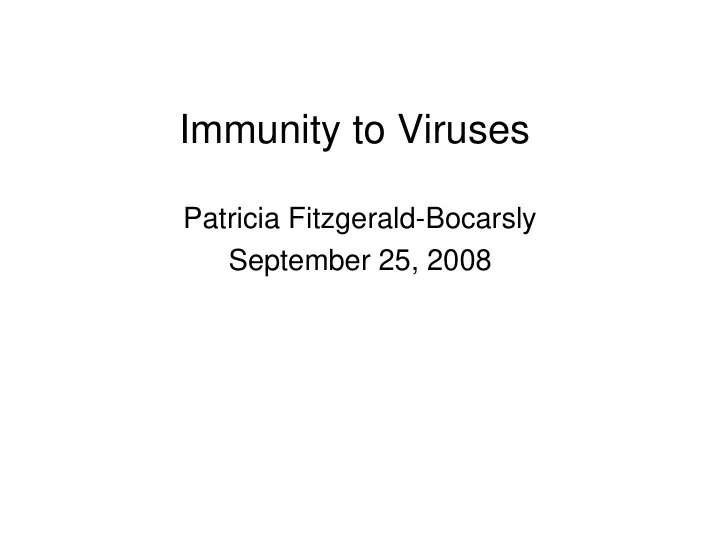

Immunity to Viruses Patricia Fitzgerald-Bocarsly September 25, 2008
The Immune System Deals with a Huge Range of Pathogens Roitt, 2003
Immune Responses to Viruses • Viruses are dependent on the host cell genetic material to replicate • Heterogeneous • Mechanisms of resistance are diverse – Innate – Adaptive
Mechanisms Operate at throughout Cycle Viral Life Cycle: Different Immune Roitt, 2003
Mechanisms Differ with Site • Initial infection - replication in epithelium and draining LN – IFN-alpha, sIgA, NK • Viremia - neutralizing Ab • Replication in target organ – Complement, CTL, NK, Ab, IFN
Innate vs. Adaptive Immunity to Fig. 15-6 Viruses
Sequential Activation in Viral Infection IL-12, IFN- α
Interferon α/β in viral infection • Produced by many cell types as well as the “professional IFN- alpha producing cells”, the plasmacytoid dendritic cells (pDC) • Viral RNA or DNA recognized by a variety of signaling receptors that lead to IFN production: – Endosomal sensors of viral nucleic acids: • TLR 7 (ss RNA) (mostly in pDC) • TLR9 (DNA) (mostly in pDC) • TLR3 (dsRNA) (mostly in mDC) – Cytoplasmic sensors of viral nucleic acid:: • PKR (ds RNA) • RIG-I and MDA-5 (ds RNA) • Cytoplasmic DNA detector
Interferon α/β in viral infection • Antiviral effects • Augment and recruit NK cells • Upregulates IL-12 receptors • Upregulation of Class I and Class II MHC • Regulation/induction of adaptive immune responses • Induction of Th1 • Establishment of T memory
NK Cells • Primary role in viral infections • Viruses down-regulate Class I to escape CTL, but this makes infected cells more susceptible to lysis by NK cells • With virus-specific antibody, can mediate ADCC - important in neonatal varicella • Produce cytokines (e.g. IFN-gamma) involved in macrophage activation and adaptive responses
• Non-phagocytic cells • Lymphoid lineage but don’t rearrange receptors • Kill by release of granule contents in the area of an immunological synapse • Perforin pokes holes in the membranes, proteases digest cell • Target cell dies by apoptosis
Natural Killer Cells Fig 12-6 Abbas
Recognition of Virus-infected Targets by NK Cells “ Missing self”: whereas CTL must see antigen with MHC Class I, NK cells are inhibited by the expression of MHC Class I - healthy cells are not killed. Many viruses downregulate MHC Class I to escape from CTL but become Fig 12-7 sensitive to NK.
IL-12 in Viral Infections • Produced by antigen presenting cells (some DC, macrophages) in response to viruses • Triggered through TLR or other pattern- recognition receptors • Activates NK cells, Th1 cells, CD8 cells • Leads to upregulation of cell-mediated immunity against virus-infected cells
Adaptive Responses to Viruses Fig. 15-6
THE GOAL OF IMMUNIZATION: MEMORY
Antibodies in Viral Infection • Bind and neutralize extracellular virus - IgG, IgM, IgA • Bind infected cells - ADCC, complement lysis - IgG • Block virus/cell interactions - IgG, IgM, IgA • Agglutinate virus particles - IgM • Opsonize virus particles for clearance - IgM, IgG • Presence of antibody does not equal immunity! (e.g. HIV)
IgG in ADCC against Virally-Infected Cells
Cytotoxic T Cells in Viral Infection: Activation in the Lymph Node
Cytotoxic T Cells Effector Fxn. In the Periphery
Cytotoxic T Cells in Viral Infection
QuickTime™ and a Cinepak decompressor are needed to see this picture.
Virus-induced immunopathology (when too much of a good thing isn’t so good!) • Immune complexes - glomerulonephritis and vasculitis • Direct damage - lysis of infected and bystander cells • Autoimmunity - diabetes? MS? • Release of activating mediators - chronic inflammation • Damage by CD4 cells, for example in herpes stromal keratitis
Viruses and Immune Evasion • Viruses spend a great deal of their genetic machinery on immune evasion • Diverse mechanisms of immune evasion
Viral Immune Evasion Strategies • Latency • Antigenic variation - individual and population level • Cytokine inhibition (inhibitors, decoy receptors, immunosuppressive cytokines, etc.) • Transcription factor decoys • Interruption of antigen processing/presentation • Infection of immunocompetant cells
Assignment: Create a resume to apply for the job of immunoevasive virus. The resume should have: • Introduce yourself (name, education: i.e. type of virus, host) • Goal: focus on ability to replicate and evade the immune response • Specific Experience (job history): – Whom do you infect? • What cells are infected? – Attributes: briefly describe the disease you cause – Specific skills: how do you evade the immune system? **concentrate your effort here • Provide 2 references!!!! • Journal articles that can attest to your qualification for the job and your ability to get along with others (not kill all the hosts)!!!!!!
Choose: • HIV • Measles • Herpes Simplex • Epstein Barr Virus • Pox virus (e.g. vaccinia, smallpox, etc.) • Cytomegalovirus • Rhinovirus
Recommend
More recommend